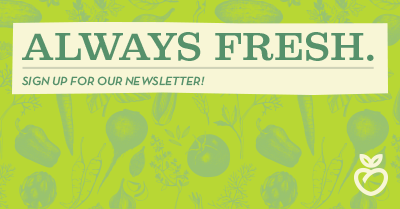Next Level Veggies: Fermentation for Everyone

Whether you’re shopping in our produce department, at a farmers’ market, or eating out of your own garden this season, I’m sure you’ve noticed how abundant the harvest of fresh food is right now! Personally, I find it a little overwhelming (in the best way possible, of course). I want to eat everything all the time, and I can’t keep up! New things appear on our shelves every day, and each is better than the last. How can we keep enjoying our favorite staples, explore the ephemeral seasonal items, and keep some around for times of less abundance? I have an answer for you, and it’s a practice as old as agriculture itself. I’m talking about fermentation.
Yes, fermentation is an ancient alchemical process by which raw ingredients are combined in such a way that biological reactions take place and fresh perishable food is transformed into a mystic concoction that only gets better with time. In wild-fermented foods, the healthy bacteria inherently present in raw fruits and veggies are manipulated to transform these foods, introducing new intriguing flavors, preserving raw nutrients and unlocking vital minerals for our bodies to use.

Some lucky Healthy Living staff got the opportunity to learn about wild fermentation last week from the very man who wrote the book on this art, Sandor Katz. In his intensive, hands-on class, we took fruits and veggies grown by the same Vermont farms who supply Healthy Living and added nothing more than sugar and salt to them, and watched as before our eyes they were transformed into probiotic soda and lacto-fermented kraut. In a few days (or weeks, or months, depending on your taste), you can enjoy your next-level veggies as a savory, nutritious kraut, and your ripe berries as a delicious effervescent tonic—and you won’t believe how easy it is.
The vegetable versions most are familiar with are sauerkraut, simply cabbage and salt, and kimchi, a Korean-style kraut usually made with nappa cabbage, carrots, scallions, radishes, garlic, ginger and hot pepper as well as salt. In class, we made a hybrid ferment, using many of the ingredients of kimchi minus the chili pepper and ginger. This “kraut-chi” has the variety of kimchi with a milder flavor. If you don’t like some or any of these classic veggies, you can use almost anything—roots, brassicas, nightshades, stonefruit, apples—even watermelon rind and rhubarb! If you can grow it, you can sour it. Not everything will ferment to your liking—greens have a bitter flavor and slimy texture on their own and work better in a mixture—but the possibilities are as varied as your own preferences, and the only way to find out what you like is to experiment!

Begin by trimming and rinsing the dirt off of your produce—but no need to scrub too hard or peel; the bacteria in the outer layers will catalyze the fermentation process. Then grate, chop or slice everything into small pieces. Different sizes are OK as long as you are exposing plenty of surface area—the more, the better to achieve even texture in the final product. Mix all your prepped produce together in a large bowl, crock, or bucket—glass, plastic or ceramic are great, and a metal mixing bowl is fine at this stage, but don’t use metal as the fermentation container, as the salt can corrode it.
The next step is to add salt—any salt will do, but keep in mind that the less refined it is, the more minerals will be made bioavailable by fermentation, and the more nutritious the final product will be. A sea salt is ideal for this reason. You want to aim for roughly 2% salinity in your kraut, so measure based on the volume of your veggies. The saltiness can be adjusted to your liking, but you want to make sure there’s enough to get the process going.

Using your hands, massage, pound or squeeze the slaw to evenly mix in the salt, and then keep kneading it. This will slowly release all of the water from the veggies and produce your brine. Keep going until the volume of the slaw is reduced by about half. When your veggies are good and tender and there is some liquid in the container, you can stop and let things sit for a few minutes. More water will be released.

While the veggies marinate, you can prepare your fermentation container. In class, we mixed our kraut in a 5-gallon bucket, pounded it down to 2.5 gallons and filled 10 quart-sized glass jars with our fresh kraut. You want at least an inch of space at the top of the container to allow for bubbling. The final step is to press the mixture down in its container so that all of it is submerged in the brine. This will keep oxygen from acting on the kraut. Lacto-fermentation takes place by the action of lactic acid bacteria, or lactobacillus, which is an anaerobic process. This means it happens in the absence of oxygen. While your kraut is fermenting at room temperature for the next few weeks, all you have to do is keep it covered with a lid (but you don’t have to seal it) and pressing it down below the brine. If you decide to seal the lid to prevent overflows, remember to burp the container a couple of times a day.

For the first few days, the bacteria will produce lots of carbon dioxide, which creates bubbles. You may see your kraut bubbling visibly or it may simply rise to the top of the jar. Using your clean hands or a spoon, just press it down until all of the bubbles below the surface are released. After about 10 days, it will be reasonably mature and you can start tasting it to monitor its flavor. When you like the way it tastes, put it in the fridge—or let it keep going! Kraut can keep fermenting in this environment for months, even years, and it will never spoil, only develop further. White mold on the surface is not necessarily a problem—just a result of the kraut coming into contact with oxygen. Scrape it off, resubmerge and let the party continue!

The ecosystem created by fermentation is amazing, and when you eat fermented foods, you are adding this community of good bacteria into your gut, and both supporting your digestion and fortifying your immune system. Not to mention the amazing anti-cancer compounds that are made accessible in simple, inexpensive foods such as cabbage by these bacteria! You could say that eating fermented foods is your best health insurance policy…but don’t take my word for it—try it yourself! Healthy Living sells both of Sandor’s books, which are full of funny anecdotes, practical instructions and recipes for both the beginner and the advanced fermenter, ranging from fruit and vegetables to grains, beans, dairy and beverages—kombucha, anyone? You can create a lifetime of living food from these books and they are worth their weight in gold. You’re the alchemist—have fun!




